Further Experiments for the Glittering Nightcap
Continuing my idea of using different stitches on the brim, I spent a little more time experimenting with stitches mentioned in Jacquie Carey’s book “Elizabethan Stitches”.
As I have mentioned before, the difference in mental models between a braidmaker and an embroiderer are clearly considerable, since although the diagrams are very clear, I spent much longer than I would have expected in puzzling them out, especially the Holly Braid Stitch. Eventually I decided that it needed a much stiffer thread than pearl cotton, and indeed, the silver thread version came together much more easily than I expected.
The Double Twisted Chain Stitch was much more straightforward to tackle, although wrangling the thread was quite a challenge at times – as you can see from the uneven stitch size and tension.
The Holly Braid Stitch is a little like a plaited braid stitch in that almost all the thread is on the surface in a neatly interlocked, textural pattern. It also uses up a lot of thread – maybe three or four times as much as the ordinary Reverse Chain Stitch that Tricia suggests for the stems. Unfortunately, I don’t think I have enough of the gold #381 in the kit to embark on stitch choices that are so profligate of thread, although if I find a spare tube in my stash, I may change my mind.
Nomenclature is a constant source of puzzlement. What Jacquie Carey refers to as Trellis Stitch – and offers an Elizabethan version for – I think of as Single Brussels Stitch. Jacquie’s is worked upward from the base cord, while Single Brussels I have always worked downward. I think I need to try again with these stitches, using something other than a metallic thread, because neither of these patches looks quite right!
Elizabethan Twisted Braid Stitch was rather more fun. Most of the thread is at the front of the fabric, making it a good choice for a metallic, or other expensive thread. The appearance – when the eye isn’t completely dazzled by sparkle! – is of an alternating twisted bar and straight bar. I clearly need to work the stitch for longer to learn to keep it consistent in width and to learn to alter the stitch length for differing effects, but I was pleased to find that the structure of this one made sense to me quite quickly.
Elizabeth Twisted Chain differs from the modern version in that both of the ends of the stitch are inside the loop, instead of one in and one out as in the modern version. It’s also worked in reverse – although that, I find, is no longer a challenge for me. The reverse versions on Chain Stitch are so much easier to work in metallic threads than the ordinary version that it is becoming second nature, and faced with a thread that is difficult for other reasons, it is also becoming second nature to consider whether working in reverse might help.
It is a constant source of delight to me to find that the things I learn, and the things I thought I would learn, are not always the same. The Online University courses, and my own experiments have given me more, and different, strings to my bow…

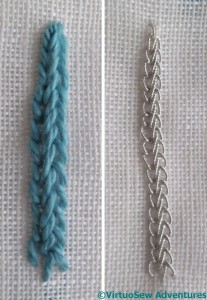
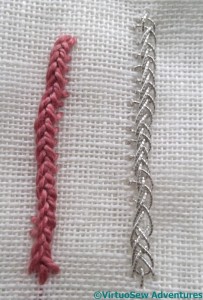
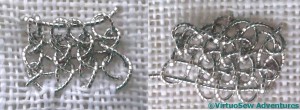
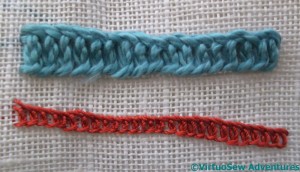
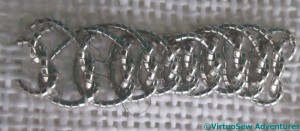

So all this is just to help you decide which stitches you’re going to use….? You have so much more patience than me! 🙂 I do think the Elizabethan Holly Braid in particular has a very pleasing appearance.
it’s great to see so many stitches I’ve never come across, this really is an interesting course. One day I’d like to take some classes in embroidery work. I look forward to seeing these stitches put into the design, the top one is really lovely and would make a great border on a stumpwork piece
I love to see your sampling, your testing and the way the images are laid out makes it very easy to appreciate your written comments. I agree with Janice, you have the patience of a saint!
Its absolutely amazing the number of ways thread can be woven together to make stitches. Plain stitches, intricate, homespun, sophisticated. Its truly a testament to creative hands and imaginative minds.
I’m just grateful you post all these wonderful, intricate stitches, which you demonstrate so beautifully, so I can ooh and ah over them!
These are fascinating stitiches, aren’t they?
You’ll see my (crochet cotton) working out of Jacqui Carey’s ‘Elizabethan trellis stitch’ here: http://suetortoise.wordpress.com/2012/06/03/disambiguation – nearly two years later, I’ve still not got around to trying out most of the stitches in her book yet. Your very nice sample of Holly Braid is tempting me to open it up and try that one and some of the others.
It does seem essential to get the right sort of thread for learning these – if it’s either too soft or too inflexible the stitch just doesn’t come out right, which makes it hard to get the knack.
some wonderful sampling of stitches. i do love that holly braid in silver.
The stitches look wonderful done in silver, especially the holly braid. Your samples are a work of art in the own right!!
I love sitting and working out how a stitch will work in another thread. It can take on a whole new personality. But I agree that you have to find the right thread for each particular application. When working with metal threads I find that kits never give me enough thread to ‘experiment’ with. I try to get more of the thread, if I can afford to, and then I can get it the way I want it.
I wish I could have the patience as you and creative as you. You’re inspiring. I must do something like it later.
What a wonderful array of stitches!
Fascinating to see your different variations on these stitches. The Holly braid is fabulous though – I love the almost knitted effect it has and it works so well in the metallic thread too.